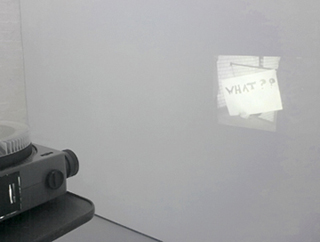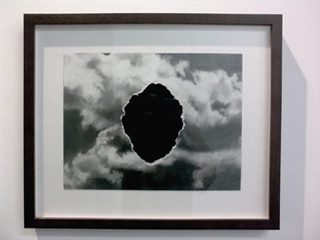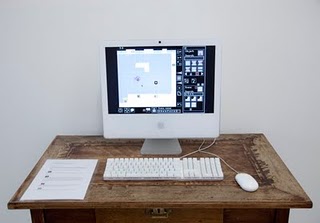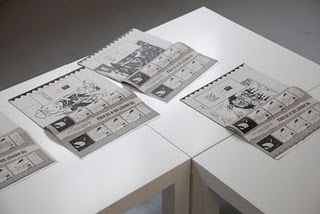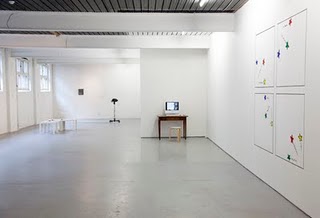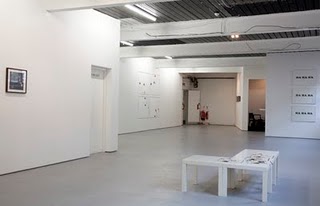The Ha-Ha Crystal
Maria Stenfors, London
Artists: Allen Grubesic, Colin Guillemet, Niamh O’Malley, Jason Rohrer and David Lynch
Curated by Chris Fite-Wassilak
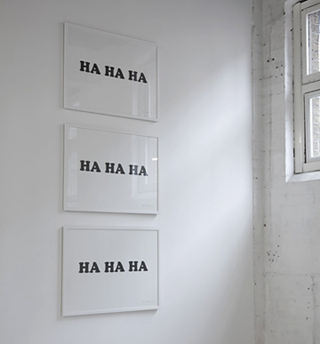
Allen Grubesic “The Last Laugh†(2007) India ink in Langton Aq 300gr. Image courtesy of the artist and Maria Stenfors
Maria Stenfors gallery’s group show “The Ha-Ha Crystal†originally refers to Robert Smithson’s analytical model for defining different types of laughter, according to what he calls The Six Main Crystal Systems, as an attempt to find answers on how to visualize the dimensions beyond our usual three:
“[R. Buckminster] Fuller was told by certain scientists that the fourth dimension was ‘ha-ha’, in other words, that it is laughter…Laughter is in a sense a kind of entropic ‘verbalisation.’ How could artists translate this verbal entropy, that is ‘ha-ha’, into solid models?†*
Here the four artists in The Ha-Ha Crystal exhibition endeavor to suggest possible responses to this rhetorical question. With Allen Grubesic’s “The Last Laugh†(2007) three identical white prints literally spell out “HA HA HA†in thick black typo, which don’t quite stand as words rather than a straightforward phonetic illustration. This quasi-iconic code crystallizes with Grubesic’s use of a generic typeface, to directly tap into our collective memory of laughter. The wall drawing entitled “Knock Out I†(2011) by Colin Guillemet arranges four black outline frames, directly pasteled onto the wall. From different corners of the frames pop out zigzag lines and stars, subdued explosion effects possibly sampled from vintage comic strips. In another piece by Guillemet, “The Last Word†(2010) a 35mm projector obstinately sifts through a full carrousel of slides, only to throw out, again and again, nearly identical images on the wall: hands in close-up, holding a piece of paper on which is written “WHAT ??â€. Both Grubesic and Guillemet use the visual conventions from graphic novels to condense every day actions into isolated pockets of signifiers, leaving the viewer with the job of linking these signs together, for better or for worst.
Colin Guillemet “The Last Word†(2010) 35mm slide projection with timer (80 slides) Image courtesy of the artist and Maria Stenfors
Niamh O’Malley “Scotoma, Clouds†(2008) pencil on paper. Image courtesy of the artist and Maria Stenfors
Likewise, Niamh O’Malley’s drawings are equally quiet and sinister, experientially rich with layered textures. In one particular striking work, “Scotoma, Clouds†(2008), O’Malley alters a pattern of clouds by manually peeling off its centre to reveal a dark hole on the paper layer beneath. The latter looks so dark that its flat surface illusorily opens onto a deep void, as a portal for the next dimension. Moving from ghastly emptiness to a ghost-in-the-machine with Jason Rohrer’s two-player storytelling game, “Sleep is Death (Geisterfahrer)†(2010) carries The HA-HA Crystal into the digital dimension, disrupting conventional narrative plots to gradually trap users into an absurd interactive word-play.
Jason Rohrer “Sleep is Death (Geisterfahrer)†(2010) Image courtesy of the artist and Maria Stenfors
David Lynch’s “The Angriest Dog in the World†(1983–1992) Image courtesy of Maria Stenfors
Notwithstanding the above artists’ idiosyncratic styles and topics, considerable curatorial juice has gone into creating of a complex web of associations between them. This is further reiterated by the placement of several printed copies of David Lynch’s comic strip ‘The Angriest Dog in the World’, on a bench, sitting in the middle of the gallery. This long-running comic strip, begun in the 1980s, act as a conceptual backdrop for the show. Since its onset, each strip has featured virtually the same progression of graphics, only conceding to differences in content within the dog’s speech bubbles. For Lynch: “[…] the memory of the anger is what does ‘The Angriest Dog.’ Not the actual anger anymore. It’s sort of a bitter attitude toward life.†Beyond Lynch, The Ha-Ha Crystal’s curator Chris Fite-Wassilak suggests more possible responses to Smithson’s initial question, within his essay “Phenomenologies of the Speech Bubble†(2008). In a particularly poignant passage he claims:
“The comic is a structure where durational events are arranged spatially, to become fragmentally linear narrative where sound is also solidified into visible form. In the speech bubble is a crossover of surface area and aural effects, an embodiment of ephemeral verbal acts […] we could view it as an example of spacetime, then somehow the 2nd dimension comes a suggestion of the 4th dimensionâ€
By looking at the differences in structure between time-based and graphic based narratives, Fite-Wassilak highlights the place where their logic clashes and collides, temporarily allowing nonsensical and unexpected narratives to spontaneously emerge, to happily diverge into new narratives directions. If, according to the late Buddhist scholar Daisetz T Suzuki, history does not exist in a linear order but like clusters of stars, perhaps The Ha-Ha Crystal’s curator would rather akin narration to a cluster of speech bubbles.
During the show (ended 6 May 2011) Chris Fite-Wassilak was running a daily blog annexing more ideas, links and thoughts around the Ha-Ha Crystal. For the blog archive: http://www.hahacrystal.blogspot.com/
Installation views. Image courtesy of Maria Stenfors
Colin Guillemet (b.1979 Paris) Lives and works in Zurich. Graduated from Central St Martins BA (2001) and Royal College of Art MA (2003). Recent shows include The Magic Show, Hayward Gallery touring; Catalogue presents.. (screening), South London Gallery; Back Yard, Lucy Mackintosh gallery, Lausanne, and Boule to Braid curated by Richard Wentworth, Lisson Gallery, London
Allen Grubesic (b.1974 Uppsala, Sweden) Lives and works in Stockholm. Graduated from Royal University College of Fine Arts, Stockholm MFA (2003) Recent solo exhibitions include the Charles Bank Gallery, New York, and Alida Ivanov Gallery, Stockholm, and the group exhibition ‘Silence is Appreciated’ at Manzara Perspectives, Istanbul.
Niamh O’Malley (b.1975 County Mayo, Ireland) Completed PhD on Split studio and theoretical research, University of Ulster, Belfast (2003) Forthcoming exhibitions include Dublin Contemporary & Green on Red Gallery, Dublin, while recent exhibitions include Centre Culturel Montehermoso, Vitoria-Gasteiz, Spain, Centre Culturel Irlandais, Paris, Gaain Gallery, Seoul, South Korea, Void, Derry, Northern Ireland, and Galleri Flach-Thulin, Stockholm, She is currently a resident artist at TBGS Studios, Dublin.
Jason Rohrer is currently parenting and making video game art in Las Cruces, New Mexico. His games can be found at http://hcsoftware.sourceforge.net/jason-rohrer/
Artist, filmmaker, and musician David Lynch was born in Missoula, Montana. ‘The Angriest Dog in The World’ ran from 1983 to 1992 in the weekly newspaper LA Reader, as well as Creative Loafing and the Village Voice. Here are included examples of the comic strip printed in the comic book anthology Cheval Noir.
Chris Fite-Wassilak is a writer and curator based in London. He is a regular contributor to Frieze, Art Papers and Art Review, as well as writing for Flash Art, Art and Australia, Artforum.com, and the Visual Artists Newsletter Ireland. Recent curatorial projects include Simile: Lucy Conochie at Studio 1.1, and a forthcoming exhibition with David Beattie and Karl Burke at the Galways Arts Centre in September. Fite-Wassilak’s website: www.growgnome.com
* Robert Smithson, “Entropy and The New Monuments”, in Robert Smithson: The Collected Writings, edited by Jack Flam (Berkely: University of California Press 1996) p.21
By Oli Sorenson and Miwa Kojima

